#west sicily
Explore tagged Tumblr posts
Text


afl
#afl#2024#captains#jordan dawson (adelaide)#harris andrews (brisbane)#patrick cripps (carlton)#darcy moore (collingwood)#zach merrett (essendon)#alex pearce (freemantle)#patrick dangerfield (geelong)#touk miller (gold coast suns)#toby greene (gws)#james sicily (hawthorn)#max gawn (melbourne)#jy simpkin (north melbourne)#connor rozee (port adelaide)#toby nankervis (richmond)#jack steele (st-kilda)#callum mills (sydney)#oscar allen (west coast )#marcus bontempelli (western bulldogs)
7 notes
·
View notes
Text
African Moors: The True History and Legacy of the Term "Moor" in European Culture
The term “Moor” has been woven into the historical fabric of Europe for centuries, conjuring images of African influence, military prowess, and cultural impact. Originating from the Greek word “mavro,” meaning “black” or “blackened,” the term was used by the ancient Romans and Greeks to describe indigenous Africans. Contrary to modern misconceptions, the word “Moor” is not simply a synonym for…

View On WordPress
#African History#African in Europe#African Moors#Berbers#Black Moors#Moor#Moor Culture#Moor History#Moors of Iberia#Moors of Sicily#Moors of the Maghreb#West African
2 notes
·
View notes
Text
youtube
#vasco nacho creative#guitar monk#death to the world#Vasco Nacho Mucci Tomatoes Sicily#Ethiopia Waynesburg West Virginia
1 note
·
View note
Text
In this they may have been typical of Mediterranean merchants; though less well documented, commerce was apparently just as international and profitable in Ifriqiya and Sicily, where Muslim Palermo became a boomtown trading with Christian northern Italy.
"Why the West Rules – For Now: The patterns of history and what they reveal about the future" - Ian Morris
#book quote#why the west rules – for now#ian morris#nonfiction#mediterranean#merchants#typical#documentation#commerce#international trade#profitable#ifriqiya#africa#tunisia#sicily#muslim#palermo#boomtown#christian#northern italy
0 notes
Text
By 1500 BCE the Hurrians had carved out a kingdom called Mittani and Mycenaeans had conquered Crete (Figure 4.4).

"Why the West Rules – For Now: The patterns of history and what they reveal about the future" - Ian Morris
#book quotes#why the west rules – for now#ian morris#nonfiction#hurri#kingdom#mittani#mycenaean#conquered#crete#hittite#kizzuwatna#assyrian#sicily#sardinia#italy#pottery
1 note
·
View note
Text
i really do wish gentiles understood how utterly decimated the jewish diaspora was by the end of the 20th century in the wake of the wave of pogroms in eastern europe, the shoah and its aftermath, and the expulsions across north africa and south west asia. in the early 1900’s, around 50% of the world’s jewish population lived outside of eretz yisrael or the us. today, that number is 13%. there are countries who had large jewish populations at the turn of the 20th century that now have no jewish presence. there has not been such a large wave of expulsions and fleeing since the spanish inquisition — which is another horrifically traumatizing series of events that gentiles don’t understand the enormity of.
during the spanish inquisition, almost half a million jews were forced on pain of death to convert or flee. thousands were killed, hundreds of thousands fled. until the shoah, it was the single most massive trauma in jewish history since the siege of jerusalem and expulsion from judea. jews made up nearly a quarter of spain’s population and had been there for centuries. some of our most important texts were written there. ladino developed there, sephardic music, culture, and identity. and then it was gone. everywhere the inquisition could reach, from spain to naples to sicily to malta to the americas, the jewish populations were brutalized, genocided, and expelled. it changed the course of jewish history forever.
in the 20th century, within the span of 50ish years, hundreds of thousands of jews were killed in or fled horrific pogroms in eastern europe, a third of the entire jewish population was systematically murdered within the span of a few years, centuries old jewish communities weren’t just expelled but almost entirely wiped out which led to the loss of centuries old diaspora languages and traditions, and nearly a million jews were expelled from places they’d lived for hundreds or even thousands of years.
like. do you understand? do you understand the kind of communal trauma that kind of massive global upheaval has on a people? the expulsion of 300,000+ jews from spanish territories was enough to leave a centuries old mark on the jewish community. do you understand the impact that the murder of over six million and violent displacement of over 2 million jews will have on the jewish psyche and on jewish history? do you have any idea how earth shattering the last century has been for the jewish people? do you have any idea what we’ve lost? what’s been violently stolen from us? can you try?
962 notes
·
View notes
Photo

Segesta
Segesta (or Egesta), located in the north-west corner of Sicily, was an important trading town from the 7th century BCE onwards. Situated on the strategically advantageous slopes of Mt. Barbaro, yet still close enough to the coast to support a trading port, Segesta established itself as the most important regional town of the Elymi people. Flourishing in the 5th century BCE, Segesta continued to hold important status as a trading centre into Hellenistic and Roman times. Today, the site has two of the best-preserved Classical monuments anywhere and they are impressive testimony of Segesta's one-time prosperity - a 5th century BCE Doric temple which, at least externally, is reasonably intact and an equally well-preserved 3rd-2nd century BCE theatre which provides its audience with a stunning view towards the nearby Gulf of Castellamare.
In Mythology
One of the symbols often associated with Segesta is a dog, which is seen, for example, on 4th century BCE coins. The animal may refer to the founding myth that describes a dog as the personification of the river god Crimisus. It was he who fell in love with a local nymph (Egesta), and their resulting offspring, Egesto, was credited with being the founder of the city. In the Roman mythology which sought to link Segesta with her ancient Roman origins, the Trojan hero Aeneas stopped off on Sicily during his long wanderings from Troy to his final destination Italy and the founding of Rome. Aeneas, then, according to Virgil, founds Acesta (later to become Segesta). Aeneas escaping Troy is portrayed on bronze coins from Segesta minted during the reign of Augustus.
In yet another version of the mythical events surrounding the founding of the city, the principal character is one Aegesto (or Aceste), who was born in Sicily to a Trojan mother. Aegesto returned to Troy when he was an adult, but following the sacking of the city in the Trojan War, he and a group of survivors returned to Sicily. First establishing themselves at Erice, Aegesto later relocated, setting up a new city at Segesta.
Continue reading...
131 notes
·
View notes
Text
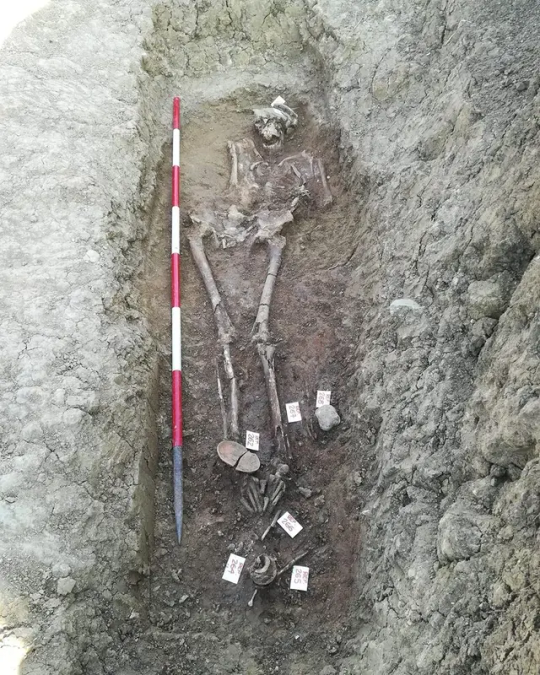
Imperial Roman Necropolis Found in Sicily
Archaeologists with the civil engineering company Italferr have unearthed a Roman settlement and necropolis during the construction of the new Palermo-Catania-Messina railway link in Sicily.
Located on a hill overlooking the Dittaino River, this Roman settlement dates back to the mid-1st to the 3rd century CE. The site’s strategic position, offering control over the Dittaino Valley and key communication routes, underscores its importance during its time.
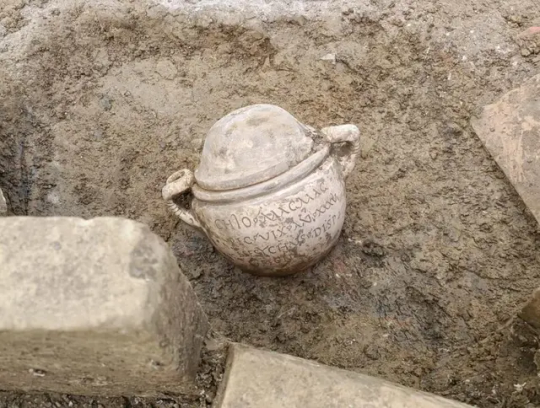
Excavations have revealed a well-organized rustic villa complex, known as a villa rustica, which was central to the settlement’s agricultural and livestock activities. The villa’s central room, flanked by three ambulatories, has been identified through traces of collapsed roof materials. The villa’s remains indicate not only a residential function but also a productive role, likely linked to the region’s agricultural economy. Remnants of pavements and collapsed structures further emphasize the villa’s significance.
To the west of the settlement lies an extensive necropolis with 168 burials, showcasing a highly stratified society. The burials range from simple earth pits covered with tiles to monumental tombs, indicating significant social diversity within the community.

Among the notable graves is a bastum, or mound grave, which contained exceptional funerary offerings, including five necklaces, two gold rings, and a cinerary urn made from Carrara marble.
The urn bears an inscription dedicated to a “Magnus Magister Pecoris,” an official responsible for overseeing sheep breeding, and another inscription mentioning a “dispensator” who donated the urn to the deceased.
Magnetometric surveys to the east of the settlement have identified a possible cult area. Archaeologists found traces of burnt animal bones, ash layers, and alluvial deposits in a natural channel, indicating ritual activities. Among the recovered objects are oscilla masks, bone needles and pins, and a die with an undeciphered inscription. These artifacts suggest the performance of rituals and offerings to various deities in connection with festivals and ceremonies.
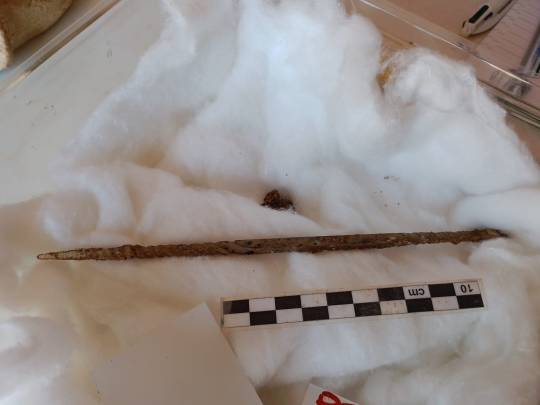
Italferr, a company under the Ferrovie dello Stato Italiane Group, has been at the forefront of integrating archaeological expertise with modern engineering practices since the 1990s. The company’s proactive approach to preventive archaeological investigations has proven instrumental in preserving cultural heritage while advancing infrastructure development.
The excavations at the Palomba-Catenanuova section began in 2020 in collaboration with the Soprintendenza Beni Culturali e Ambientali di Enna.
By Dario Radley.


#Imperial Roman Necropolis Found in Sicily#Dittaino Valley#ancient tomb#ancient grave#ancient necropolis#ancient artifacts#archeology#archeolgst#history#history news#ancient history#ancient culture#ancient civilizations#roman history#roman empire#roman art#ancient art
188 notes
·
View notes
Text
So I was in Greece and found out it was a lie.
All those episodes of Xena Warrior Princess and Iolaus: The Legendary Journeys.
They.
Were.
LIES.
Did you know that throughout ALL of Greece for all the centuries leading up to when the Romans invaded, all of the many myriad city states and colonies-- west to Sicily and south to Africa and north east to Asia Minor, all of them: no temples to Ares.
None.
All the other gods? Yup. Hell, they even imported Isis from Egypt so she has shrines on Delos. DELOS. The holy birthplace of Apollo. Shrines to the Egyptian goddess Isis.
But Ares? No.
And in both shows that was the WHOLE plot. It was always about Ares and his temples and shrines. Even the Young Hercules spin off with Ryan Gosling as Hercules and the actor who would later be Fili the Dwarf playing young Iolaus, Ares was always in his temples and always trying to protect his temples from being smashed up or destroyed. And I visit Greece for the first time in my life and go to all these amazing sites-- Delos, the canal at Corinth, Olympia, Delphi, Athens, Ithaca, Patmos, Tinos etc. and . . . no Ares. No temple to Ares.
And when you visit Greece and they take you to the ruins of the temples of Athena and Zeus and Apollo etc. you learn that people built temples for the gods to use as like vacation homes when they didn't want to stay on Olympus.
All those city states. All those colonies and during the entire Hellenic period no one built one single temple to Ares according to the docent at the Delphi museum.
Apparently no one wanted Ares as a neighbor.

#ares#iolaus#xena#greece#ancient greece#poor ares#I think it was the fact that Eris would always be with him#Her and Strife#No one wanted them around when they could have Athena as a summer house neighboor#Athena always traveled with Nike#goddess of victory#What did Ares get?#Strife#Eris#Demos#Phobos#And I did not stutter#I said Iolaus the Legendary Journeys#And I meant it#The non Ryan Gosling Hercules actor knows what he did
58 notes
·
View notes
Note
Hello lovely internet person! Folklore question: there are many stories where transformation serves an important story beat- either a character being cursed into an animal form and having to break it, the antagonist being transformed as punishment, cloaks that give the wearer the power to transform used in various ways, etcetera. I was wondering if there are any stories you know of where the character wants to/needs to transform and acquires the means to do so, but it ends up going terribly wrong?
I’m plotting a story where one of the arcs revolves around a character transforming themself both for body dysmorphia reasons and to better fit into society- but, unfortunately, it ends up going wrong in some way which I haven’t fully planned out yet. I’m trying to use a lot of folklore and fairytale themes and beats in this story, so I’d love to know if there’s any older stories that follow this kind of arc! (I know it’s a fairly common modern storytelling arc)
I think the exact motif of a story's protagonist seeking out a way to physically transform themselves at all - whether successfully or unsuccessfully - is rare in European folklore. Perhaps because magic of this kind is usually reserved for non-human or evil characters. (I can imagine there are examples from cultures who do not always treat the human body as quite so static, like the Aboriginal or First Nation traditions. But I do not know any examples off the top of my head and would not recommend drawing from those more spiritual tales for modern fantasy).
That being said, these are the stories I know that seem most closely related to what you're looking for:
● In The Story About Ciccu (Sicily) a greedy King has his servant Ciccu kidnap the beautiful princess he wants to marry, the princess says she will not marry him until he orders Ciccu to jump into a lit oven. Ciccu's magic horse (which the princess knows he has) warns Ciccu to rub himself all over with the horse's sweat before jumping into the oven. He does so and instead of burning he comes out even more handsome than he was already. The King demands to know how he did it and Ciccu tells him he rubbed himself with old grease. The King does so, and burns to death. (A similar motif shows up in the Sicilian The King Who Wanted a Beautiful Wife and the Venetian The Three Crones, in which the way to become young and beautiful is to flay one's skin off, but this is a lie not based on any magical truth, so it's not as applicable here.)
● In The Fairy Ointment (Wales, West England) a woman is fetched by a fairy (or pixie) to be midwife for his fairy wife in labour. She is given ointment to rub on the infant's eyes and slyly puts some on her own right eye as well. This gives her the power to see the fairies, even when she is returned to the human world. When she sees the fairy father and greets him, however, he finds out what she has done and makes her blind in her right eye to take the magic sight from her.
● There are various stories (eg. The Hunchback of Willow Brake, The Gifts of the Mountain Spirits, The Old Man with the Wen) about two men who have a similar physical defect (in the European versions a hunched back, in the Asian versions a skin growth). One encounters a host of fairies, dwarves, elves, goblins, etc., behaves well, and gets rewarded with the removal of the defect. When the second tries to replicate this result he behaves badly and instead gets given the defect that was taken away from the first on top of his own.
● In The Story of Caliph Stork (German literary fairy tale from 1826) an evil sorcerer makes sure the Caliph and his Grand Vizier get a scroll with a magic spell and a box of magic powder that can be used to change into animals. Once in animal form they cannot laugh, however, or they will forget how to change back. They do laugh and they become stuck in their animal forms while the sorcerer puts his son on the throne. With some help from a princess who was turned into an owl by the sorcerer they eventually manage to become human again and defeat the sorcerer.
● In Jan the Sorcerer (Belgium), The Thief and his Master (Germany) and The King of the Black Art (Scotland) the protagonist learns magic and helps his poor father by changing himself into a steer or horse to be sold at market. But the bridle/lead must not be sold with him. The father forgets this and the son is unable to change back into a human and escape, until he can trick someone into taking the bridle off him.
That's what I've got! Hope it's helpful ^^
#I don't know if this is good inspriation for your vision#your protagonist sounds sympathetic and as you can see most of these stories are rather unkind to the transformer#cloudgremlin#folklore#fairy tales
45 notes
·
View notes
Photo

2023 November 14
Three Planets Rock Image Credit & Copyright: Giovanni Passalacqua; Text: Liz Coelho (Pikes Peak)
Explanation: In the fading darkness before dawn, a tilted triangle appeared to balance atop a rock formation off the southern tip of Sicily. Making up the points of the triangle are three of the four brightest objects visible in Earth’s sky: Jupiter, Venus and the Moon. Though a thin waning crescent, most of the moon’s disk is visible due to earthshine. Captured in this image on 2022 April 27, Venus (center) and Jupiter (left) are roughly three degrees apart -- and were headed toward a close conjunction. Conjunctions of Venus and Jupiter occur about once a year and are visible either in the east before sunrise or in the west after sunset. The featured image was taken about an hour before the arrival of the brightest object in Earth’s sky – the Sun.
∞ Source: apod.nasa.gov/apod/ap231114.html
169 notes
·
View notes
Photo
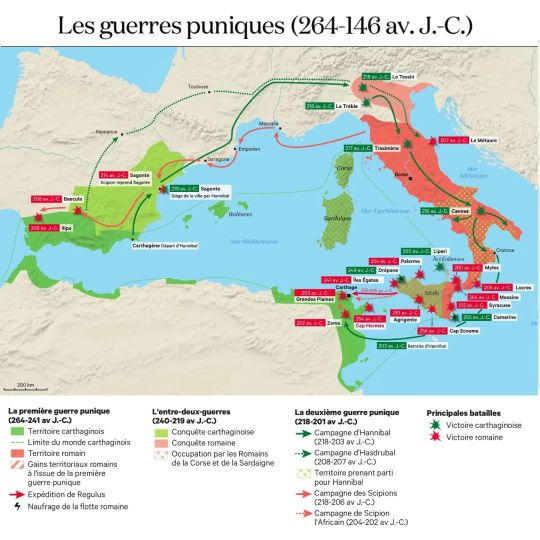
The Punic Wars, 264-146 BC
« Atlas historique mondial », Les Arènes, 2019
by cartesdhistoire
Rome and Carthage stood as the dominant powers in the western Mediterranean. Between these two influential states lay the island of Sicily. Situated at the crossroads of Europe and Africa, and bridging the eastern and western Mediterranean basins, Sicily held immense strategic importance. Rich in wheat and boasting a heritage of prosperity bestowed by both the Carthaginians in the west (in Palermo) and the Greeks in the east (in Syracuse), the island flourished. The Carthaginians established their capital at Lilybaea (modern-day Marsala) and maintained a major naval base at Drepane (modern-day Trapani).
In 264 BC, the onset of the First Punic War marked the first engagement of Roman legionnaires outside of Italy. While battles were fought in open fields, guerrilla warfare, and sieges, the defining feature of this conflict lay at sea. The pivotal Battle of the Aegate Islands in 241 BC resulted in the defeat of the Carthaginians, triggering another conflict, the far more perilous Mercenary War, on African soil. Fueled by grievances over unpaid wages, mercenaries and local allies revolted against Carthage, plunging the region into turmoil until order was restored by Hamilcar in 238 BC. A peace treaty with Rome was signed on March 10th.
The Second Punic War, commencing in 218 BC, was marked by an intriguing characteristic: personalization. The conflict became synonymous with the personalities of Scipio, later known as "the first African," and Hannibal, one of history's greatest military commanders. Hannibal's audacious invasion of Italy, driven by a desire to avenge Carthage's honor, catalyzed the war's escalation.
The war culminated in the Battle of Zama in 202 BC, leading to the signing of a final treaty in 201 BC. From this point forward, Rome emerged unchallenged in the Mediterranean. However, it wasn't until 197 BC that the Senate formally established the two provinces of Spain.
77 notes
·
View notes
Text

The Strait of Messina, Sicily from the west, with a view of the fortifications and port, Alexandre-Hyacinthe Dunouy
40 notes
·
View notes
Text

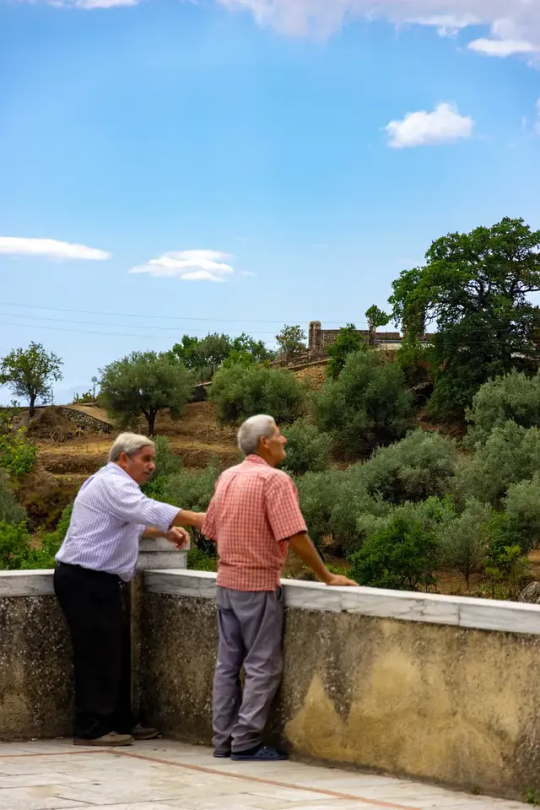
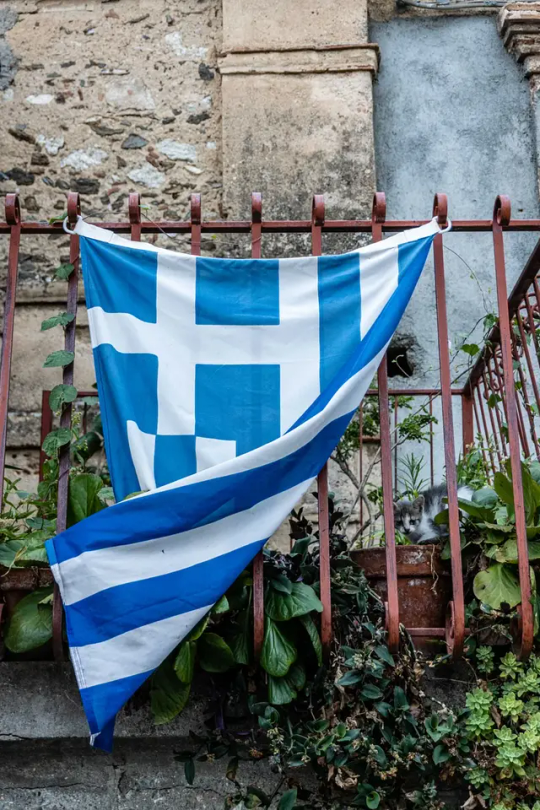
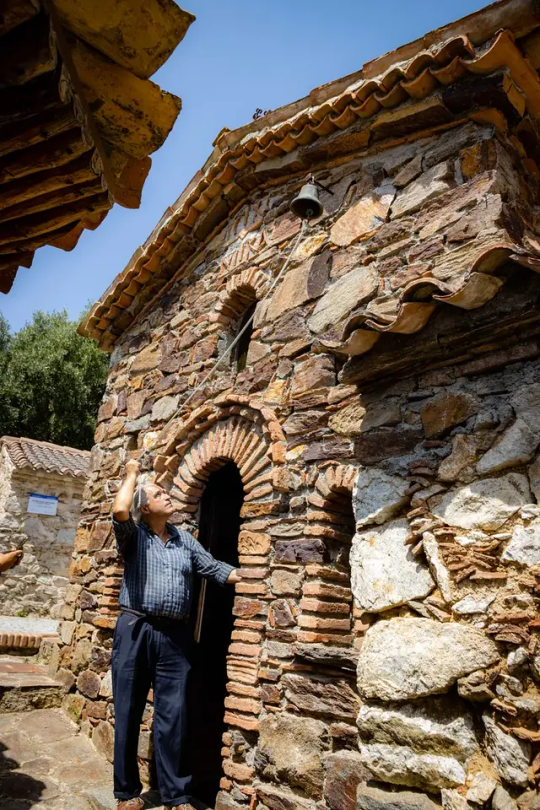

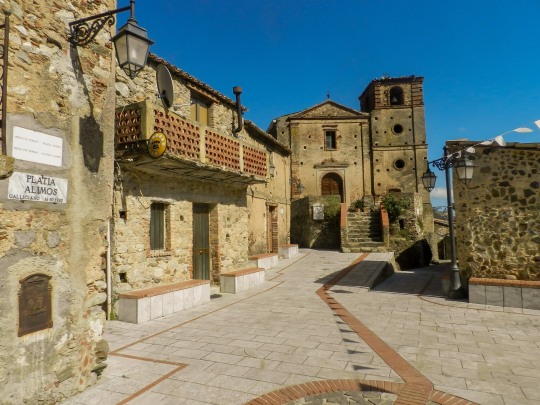

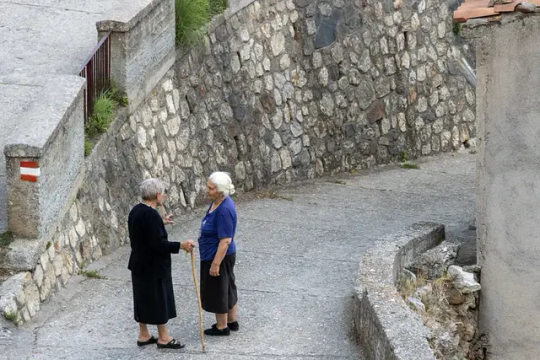
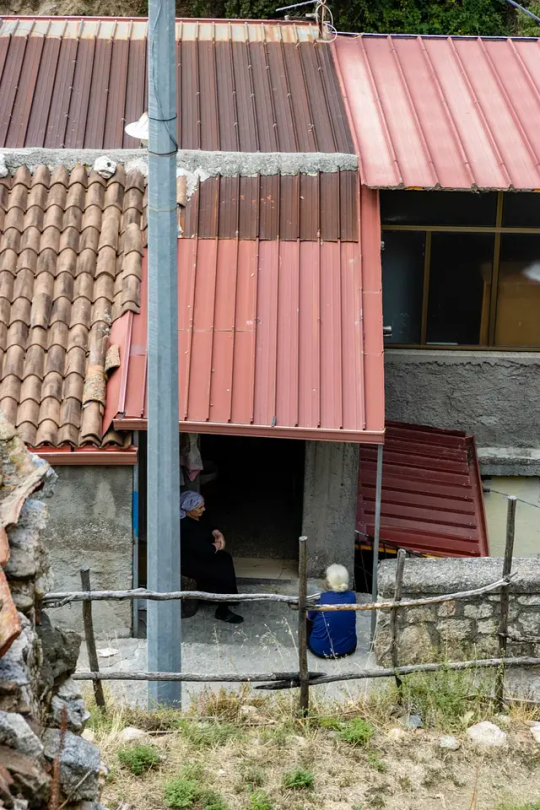

Gallicianò, Calabria, Italy
Gallicianò, in Calabria, is the only remaining original Greko-speaking settlement in the Aspromonte Mountains. Locals have not been forced to move or resettle on the coast like other Greko settlements.
Italian as we know it today was not always spoken throughout Italy. The Italian language did not become the staple language until well into the end of the 19th Century during the process of Italian unification, or the Risorgimento. Until then, the Italian peninsula was made up of Italo-Romance dialects and smaller minority languages that were differentiated by region and historical influences. Once unification was complete, the Tuscan dialect was ushered into power as the official language of the Italian nation. This became the beginning of the modern end of the Greek language in Calabria, or what it is known today as Griko.
WHY SHOULD IT MATTER?
There exists today a tiny enclave of Greek-speaking people in the Aspromonte Mountain region of Reggio Calabria that seem to have survived millennia...perhaps since the Ancient Greeks began colonizing Southern Italy in the 8th and 7th Centuries BC. Their language is called Griko. They survived empires, invasions, ecclesial schisms, dictators, nationalistic-inspired assimilation, and much more. Griko is a variety of the Greek language that has been separated from the rest of the Hellenic world for many centuries.
To help bring more perspective, Greek was the dominant language and ethnic element all throughout what we know today as Calabria, Puglia, and Eastern Sicily until the 14th Century. Since then, the spread of Italo-Romance languages,
along with geographical isolation from other Greek-speaking regions in Italy, caused the language to evolve on its own in Calabria. This resulted in a separate and unique variety of Greek that is different from what is spoken today in Puglia.
A BRIEF HISTORY
The struggle for the survival of Hellenism after antiquity is typically associated with Ottoman occupation in the Eastern Mediterranean, not the Italian peninsula. Few history books I read growing up ever mentioned any type of Greek history or presence in Italy after the glorious era of Magna Graecia. But to dig a little deeper means that we must look at what happened to this ethno-linguistic group after antiquity.
There are many theories or schools of thought regarding the origin of the Greko community in Calabria. Are they descendants of the Ancient Greeks who colonized Southern Italy? Are they remnants of the Byzantine presence in Southern Italy? Did their ancestors come in the 15th-16th Centuries from the Greek communities in the Aegean fleeing Ottoman invasion? The best answers to all of those questions are yes, yes, and yes. This means that history has shown a continuous Greek presence in Calabria since antiquity. Even though different empires, governments, and invasions occurred in the region, the Greek language and identity seemed to have
never ceased. Once the glorious days of Magna Graecia were over, there is evidence that shows that Greek continued to be spoken in Southern Italy during the Roman Empire. Once the Roman Empire split into East (Byzantine) and West, Calabria saw Byzantine rule begin in the 5th Century. This lasted well into the 11th Century and reinforced the Greek language and identity in the region as well as an affinity to Eastern Christianity.
What's even more fascinating is that Calabria was apparently a Byzantine monastic hub of sorts. There were over 1,500 Byzantine monasteries in Calabria and people today still remember and adore those saints. Even though Byzantine rule ended in Calabria in the 11th Century, the Greek language continued to be spoken while gradually declining in the region with the spread of Latin and a process of Catholicization. The modern-day commune of Bova may give some insight into the history of the language in the region. In subsequent centuries after Byzantine rule, Bova became the heart of Greek culture in Calabria as well as the seat of the Greek church in the region. It is important to note that the liturgical language of the region was Greek until 1572 when Bova was the last in the region to transition to Latin.
Not much is known of what took place between the end of the 16th Century and the Italian Risorgimento in the 19th Century, but there are a couple of details to mention. First, due to multiple invasions and piracy, much of Calabria's coastal population moved into the mountainous interior. According to Olimpia, the isolation and geography of the Greko communities in Calabria definitely worked to the advantage of preserving the language over centuries. We can also possibly conclude that occasional migrations of Greeks to Calabria from the Aegean could have taken place in the 16th and 17th Centuries in response to the Ottoman invasion. And according to Tito, there is even evidence that a 17th Century mayor of Bova wrote poems in Griko.
Even though the Greek language had already been in great decline since the departure of the Byzantine Empire in Southern Italy and the spread of Catholicism with Latin liturgy, the language seemed to have quietly survived several centuries in the mountains of Calabria.
TODAY
Once the Risorgimento finally took place, the modern Italian language finally arrived in Calabria at the end of the 19th Century. The Italian language that arrived was essentially the Tuscan dialect that was chosen as the national language. The Italian language has only been spoken in Calabria for around 100 years.
Due to the complexities of the Risorgimento and the new multifaceted Italian state (Northern Italy vs. Southern Italy), there was a new wave of mindsets that was ushered into Calabria and surrounding Southern Italian regions. This deeply affected the Greko community and language.
The shame and embarrassment of speaking Griko began in the 20th Century and it intensified during the Fascist movement. The mentality of 'we must be Italians' affected the way the Griko community raised their children.
Until the 1960s, there were no roads, electricity, or plumbing to most of the Greko villages. When the schools arrived, Italian was the taught language and Greko was learned at home. There was no government assistance back then for the Greko language. Italian government did not care about this language.
Furthermore, unlike other minority languages in Northern Italy, the Greko community was not located in a border region. The Italian government did not pay much attention to the Greko language or did not help preserve it also because its speakers did not pose a threat of secession or independence much like the Northern Italian minorities or the Basques and Catalans of Spain.
All of these factors have led to the current status of the Greko language as it remains in severe decline and near extinction.
Written by John Kazaklis
Photos by Giuseppe Cillis
Follow us on Instagram, @calabria_mediterranea
#Gallicianò#calabria#italy#italia#south italy#southern italy#mediterranean#greek#byzantine#byzantine art#griko#italian#landscape#italian landscape#europe#landscapes#mountains#mountainscape#mediterranean sea#seascape
32 notes
·
View notes
Text
#that Mediterranean climate might cure me#a blogger can dream#crowd sourcing the direction of my midlife crisis
101 notes
·
View notes
Note
Do you have any thoughts/theories on what it would've been like if Alexander ever returned to Pella? (sorry if this was already asked, tumblr's search system isn't really helpful)
What if Alexander Had Lived to Turn West?
First, I agree on Tumblr’s search system. It’s become increasingly bad. Even I can’t find posts I KNOW I made and tagged. I’m starting to compile a list of the more important (and lengthy) posts on various subjects, for my own reference. I wish Tumblr would let us pin several posts, not just one. (I’ve also sent a complaint feedback to Tumblr about this.)
Anyway, to the question: before we get to the “fun” (speculative) part, let’s address how likely it is he’d GO back. And as part of that, we need to ruminate a bit on what he might have done, if he’d returned west. So, let’s play a little “What-if?”
We must also keep in mind travel time. In the modern world, we can forget how long it took back then to get from Point A to Point B. Had he lived to attack Carthage (as I think he planned to do), or at least circumnavigate Arabia—both are on the southern coast of the Mediterranean. (See my tweaked map with significant places I mention below marked in purple, and recall that they tended to sail along a coast, not straight through the middle.) Macedonia is in the NW corner of the Aegean Sea. Such a side-trip would have eaten up a couple months. There might have been a sneaky reason for him to do that very thing: to come at Carthage from the north. (See discussion below.) But only if Arabia was a ruse all along. If he did mean to attack Arabia (and I think he intended that too), he'd go the southern route, then after, check on the progress of Alexandria (and visit the shrines for Hephaistion that he’d ordered built), before heading west.
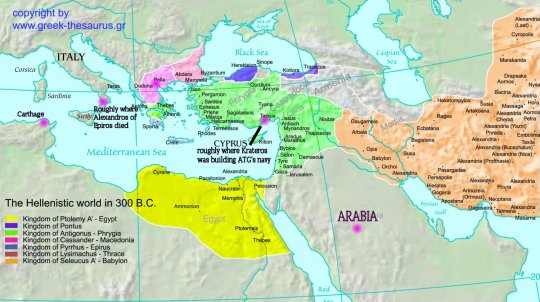
If he did choose that southern route, he wouldn’t have returned to Pella before attacking Arabia or Carthage. And after…well, Italy was on the way back, so he’d probably have gone there first. And yes, I think after dealing with Carthage, he’d have used avenging the death of his uncle (Alexandros of Epiros) as an excuse to attack the Greek colonies in S. Italy. If he’d been successful against Carthage, I’m pretty sure south Italy, and possibly the north too, would have capitulated to avoid being leveled. Even Rome. At that point, Rome was in no position to fight such a titanic military powerhouse. Too many think of Rome later and backread the extent of Roman resistance into earlier periods.
Depending on the length of the campaign (e.g., how hard was any opposition), he’d have been in his mid-30s by then. Incidentally, if you’d like a speculative “What if Alexander went West,” I recommend A Choice of Destinies by Melissa Scott. (Ignore the cover.) She does have him return to Greece first, but because Thebes is in revolt (which called him back in the first place; he never reaches India). That’s the sort of event that would get him back to Greece.
There’s been speculation in both fiction and history that he didn’t want to go home because he was avoiding “his terrible mother” (as Tarn put it). I’ve written before on why Oedipal Complexes are both very modern and very wrong to assign to Alexander. I can’t now locate that post (annoyingly), but did find this one about Alexander’s relationship with Olympias in later years. So, I don’t think avoiding Olympias would have kept him from Greece/Macedonia before going west. If anything, the opportunity to see his family would have been a draw, not a dissuading point.
So, we can postulate two possible return scenarios. The first would be a side-trip on his way to Carthage as trickery to conceal his real target. After leaving Pella, he’d circumnavigate Greece to the Peloponnese, then cross the Ionian Sea to Sicily (a typical Greek trade route), and then sail around the southern edge of the island to pop across to Carthage from the north.
In this scenario, he’d be in “swing-by” mode. He’d already asked Antipatros to bring him fresh troops, so he’d have been picking them up, or acquiring more. As a recruiting campaign, it would have been short, but he’d no doubt make several religious sacrifices at Dion, Aigai, and Pella, and perhaps even visit Delphi for a prophecy about the west.
He would not bring his Asian wives with him in either scenario. First, it’s a campaign, not a family visit. But also, he intended them to stay in Babylon (or Susa). By that point, Roxane and probably also Statiera would have given birth. If both infants were male, Statiera’s would be designated heir in Asia. If only Roxana’s was male, he’d still be the “spare” by dint of his mother’s lower birth, but better than nothing in the meantime.
It’s quite possible that he intended a divided but hierarchical rule not so different from Assyrian patterns, where one heir was sent to Babylon while Daddy ruled in Nineveh and trained the other. He almost certainly meant his son by Statiera to rule in Persia/Asia, but perhaps a different son to rule in the west—one likely not even conceived yet.
I do not think he’d have married a Macedonian. He’d be looking for another political marriage, maybe to a Greek (Athenian, Syracusan…), but more likely, he’d marry a Carthaginian after any war (or as part of any peace treaty with Carthage). At that point, Carthage was the powerhouse in the Western Med. Remember, Rome had only begun her consolidation of the Italic peninsula in the wake of the Gaulic sack of the city. Alexander in Italy might have stopped that cold.
Anyway, whatever marriage he made in the west (or couple of marriages) would have been intended to produce an heir to reign there, probably subservient to any son by Statiera after Alexander’s own death, but it’s hard to know for sure. Roxana’s son (and Herakles by Barsine) would have been third and fourth fiddles. That’s WHY Roxana killed Statiera. Her status wasn’t high enough, and her son would have been destined to be regional governor in the NE territories (where his family was from): e.g., troublesome Baktria/Sogdiana. Herakles would probably have been given Asia Minor (where his Persian family was from). (More on Herakles in another post.)
But back to this scenario: if he visited on the way, it would have been a quick trip until he was off again to another campaign. (Not unlike Daddy who, in his latter years, didn’t spend much time in Pella.)
Now, let’s look at scenario #2: a visit after any victories in Arabia, Carthage, and possibly Italy. That would be a different homecoming, less pressed for time.
That said, he wouldn’t have intended to stay. After securing the eastern/middle Mediterranean, he might have driven up into Europe, to re-secure Thrace to the Danube and scout for river connections between the Black and Caspian Seas. There aren’t any, but they didn’t know that. In fact, late in his campaign, he’d already sent somebody north to do that very scouting, so this would be a follow-up.
Thrace had fallen away from Macedonian control in in his later years, thanks to the powerful Odrysian King Seuthes III. Also, Alexander hadn’t forgotten those Celts who’d been singularly unimpressed by him early in his reign. (ha) Alternatively, he might have decided to go South of Egypt to Meroë, or west of Italy to Spain. But as he was centered in Greece, my bet is north into Eastern Europe. He already had incentive from a rebellious Thrace.
What would this homecoming have been like? STUPENDOUS, of course. All the stops pulled out. Macedonia was a gift-exchange society, so bringing home a fair bit of booty would be important. We’re told he sent presents home regularly, but this would be above and beyond. It would serve two functions:
First, he’d get to claim to be the wealthiest, most successful Macedonian king EVAR, and then some. So personal fame and honor would be on the line.
Second, throwing around oodles of wealth would be a great recruiting tool. His constant warring meant he was also in constant need of new troops. In his last years, it was clear he was happy to get troops from a variety of peoples, but the Macedonian core remained (as in the Successor Wars). Of course, continually draining Macedonia of men was bad for the future population, but “sustainability” was not in any way an ancient concept, whether in resources or in manpower. Early in his career, he did show a little awareness of this, sending back men for a “conjugal visit,” but as the campaign continued, he stopped worrying about it.
Anyway, he would also probably take the opportunity to build that giant tomb for daddy that was part of his Last Plans. Hard to know how much of those plans were either exaggerated or entirely invented, but that sounds like something he’d do. He might also have taken time to improve on local religious structures (such as at Dion), and set up something (no doubt monstrously large) at both Delphi and Olympia, as panhellenic sites.
As for the reunion with his mother and sisters, as indicated, I don’t think he was staying away to avoid Mommy Dearest. So, I expect he’d have been happy, maybe even overjoyed, to see them again.
#asks#Alexander the Great#What if Alexander had lived?#Alexander versus Carthage#Alexander versus Rome#Classics#ancient history#ancient Greece#ancient Carthage#ancient alternative history#ancient Thrace#Olympias#tagamemnon
41 notes
·
View notes